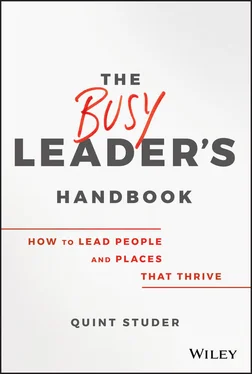In his book Built to Last , Jim Collins examined companies that last a long time compared with those that do not. The research showed that values play a critical role in organizations that are able to attain and sustain success.
Values go a long way toward shaping and sustaining a strong company culture. They have a major influence on a person’s behavior and attitude and serve as broad guidelines in all situations. I have found that once an outcome or behavior is connected to values, a person will follow through even if it makes them uncomfortable. After doing the behavior for a while, what was uncomfortable becomes comfortable.
For example, let’s say an employee left it to the last minute to order material and had to pay extra shipping, or did not take the time to research the most cost-effective product or material and ended up spending more than needed. A value of the company is financial stewardship, and you explain that not using resources as well as possible puts the company at risk. When the employee hears it explained this way, they will plan more carefully in the future.
It is a leader’s job to hardwire a strong set of values into the organization. Here’s how:
1 If you already have a strong set of company values, ask yourself how well you are communicating these and connecting staff actions to them. Review them, make sure you they are current, and if need be, revise them. (See Chapter 30to learn more about how values work in conjunction with mission and vision.) Be aware that while most companies do have written values, often in employee surveys the question “my company lives the values” is rated low. The idea is not merely to have them “posted” but to repeat and refer to them often enough that people integrate them into their own value system. As I once heard someone say, values don’t just hang on the walls, they walk in the halls.
2 If you do not have a strong set of written values, create them. Go online and look up “workplace values” and you will find many lists of example values. See which five or six best fit your department or company. Here are a few examples of some common corporate values and how leaders might live them:
Transparent
Communicate what is going on, especially with sensitive or controversial topics.
Narrate the “why” behind decisions. When people understand why, they are more likely to agree.
Live by the sunshine rule: keep everything out in the open, even if it’s not popular.
Don’t have a meeting before the meeting.
Innovative
Have a system for collecting fresh ideas. Ask people to share, and really listen to them. (Maybe ask people to contribute a new idea every month.)
Reward and recognize people who engage in the innovative process.
Be open and willing to change and progress.
Don’t demonize failure.
Focused
Plan the work and work the plan.
Pick a few things that will make a difference and commit to doing them really well.
Don’t get distracted by every shiny ball that rolls by.
Put all of your attention and resources behind the projects you can really impact.
Resourceful
Creatively look at the resources you have access to and use them in the most productive way possible.
Tap in to resources that might usually go overlooked.
This might mean identifying new resources you didn’t realize you had, or thinking differently about the resources already available.
Team-Oriented
Be a “bridge builder”: actively look for ways to connect with other stakeholders.
Create opportunities to help each other make things better for everyone.
Coordination between many moving parts.
Groups at every level working toward a shared vision or end point. Find projects they can partner on.
Accountable
Do what you’re supposed to be doing, when you’re supposed to be doing it.
Make judicious decisions that weigh all factors.
Set reasonable goals that everyone agrees on, and enforce them.
Meet deadlines and make sure others do, too.
1 Write the values down and make sure people know what they mean. Operationalize them so that people know what right looks like. Let’s take the last example from list above— accountable—and bring it to life. Here’s how employees might live this value:Do what you say you’re going to do. If you’re not sure you can do it, don’t promise it. Overpromising and overcommitting ensures that you’ll drop the ball at some point.Keep your appointments. Everyone has to reschedule sometimes, but make it the exception, not the rule.Be on time for work and for appointments. In fact, strive to be a few minutes early.Be scrupulously honest. Don’t tell little white lies. They have a way of growing bigger and bigger and eventually you will be found out.When you screw up, admit it. Don’t make excuses.Don’t assign blame and point fingers. Instead, look for ways you can be part of the solution.Follow up with team members to make sure projects aren’t falling through the cracks. Don’t just say, “Oh, well, I did my part.”If you need to work late to get it done, work late without complaining. There are also days you leave early. It all balances out in the end.If you’re out of something to do, ask for more work. Don’t wait for someone else to direct you.By spelling out exactly what the values look like in action, you go a long way toward making sure people are living them. People generally want to do a good job, giving them a roadmap will set you both up for success.
2 Make the values very visible to all employees. This is also true of your mission and vision statements. Post them prominently throughout your company. Include them in standards of behavior (see Chapter 32), emphasize them when you hire, reference them when you train a new skill, reinforce them in meetings, and so forth.
3 Connect to values on a regular basis. In written and verbal communication, connect back to values. For example:
“Susan, I saw how even though you were busy, you took time to help your coworker. This is a great example of living our value of teamwork.”
“Adam, I know getting the customer feedback you received was not pleasant; however, I noticed you were not defensive and took positive action. You really role-modeled our value of learning.”
Always add a sentence to what you write or say with a connection to values.
1 Don’t ignore violations when you see them. Remember, what you permit, you promote. When addressing people who are not taking the desired action, connect it to not living the company values. If values violations keep happening, you might find you need to put new systems in place (perhaps a better performance management process) to tackle the issue and make sure you’re not permitting/promoting it. Encourage employees to do the same.
2 Hold up the mirror. As a leader, you are always being watched. Are you demonstrating the values? An employee of an organization once asked me what to do if your boss is not living the values. I asked for more information. He shared that everyone was supposed to wear their name badge near their left shoulder. Yet the top leader never wore his name badge. I suggested he bring this up to the leader, but he was uncomfortable doing so. So when I saw the leader I mentioned that an employee had shared he felt he was not being consistent. The leader stated: “While I wish he would come to me, he is right and from now on I will wear my name badge.” I suggested he let everyone know this subject had come up, thank people for bringing it to his attention, and ask that if they notice other things to please speak up.
Occasionally, whether you’re a leader or an employee, you may be asked to do something that goes against company values. This is a challenging situation. However, it’s exactly in times like these that values are the most critical. How you respond will demonstrate whether you are truly living the values. Here are some guidelines to follow in such a situation:
Читать дальше












